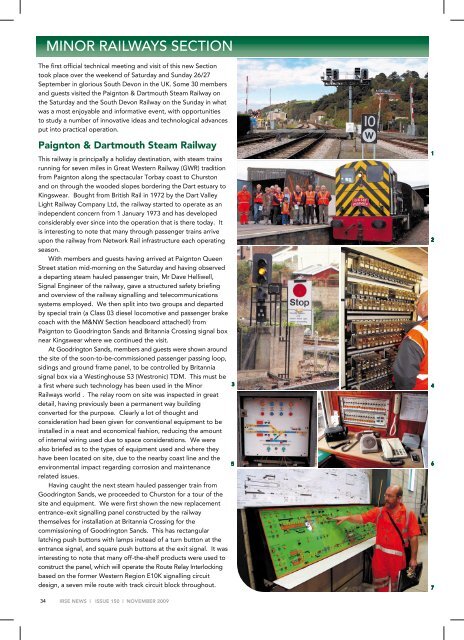IRSE News 150 Nov 09.pdf
IRSE News 150 Nov 09.pdf
IRSE News 150 Nov 09.pdf
Create successful ePaper yourself
Turn your PDF publications into a flip-book with our unique Google optimized e-Paper software.
MINOR RAILWAYS SECTION<br />
The first official technical meeting and visit of this new Section<br />
took place over the weekend of Saturday and Sunday 26/27<br />
September in glorious South Devon in the UK. Some 30 members<br />
and guests visited the Paignton & Dartmouth Steam Railway on<br />
the Saturday and the South Devon Railway on the Sunday in what<br />
was a most enjoyable and informative event, with opportunities<br />
to study a number of innovative ideas and technological advances<br />
put into practical operation.<br />
Paignton & Dartmouth Steam Railway<br />
This railway is principally a holiday destination, with steam trains<br />
running for seven miles in Great Western Railway (GWR) tradition<br />
from Paignton along the spectacular Torbay coast to Churston<br />
and on through the wooded slopes bordering the Dart estuary to<br />
Kingswear. Bought from British Rail in 1972 by the Dart Valley<br />
Light Railway Company Ltd, the railway started to operate as an<br />
independent concern from 1 January 1973 and has developed<br />
considerably ever since into the operation that is there today. It<br />
is interesting to note that many through passenger trains arrive<br />
upon the railway from Network Rail infrastructure each operating<br />
season.<br />
With members and guests having arrived at Paignton Queen<br />
Street station mid-morning on the Saturday and having observed<br />
a departing steam hauled passenger train, Mr Dave Helliwell,<br />
Signal Engineer of the railway, gave a structured safety briefing<br />
and overview of the railway signalling and telecommunications<br />
systems employed. We then split into two groups and departed<br />
by special train (a Class 03 diesel locomotive and passenger brake<br />
coach with the M&NW Section headboard attached!) from<br />
Paignton to Goodrington Sands and Britannia Crossing signal box<br />
near Kingswear where we continued the visit.<br />
At Goodrington Sands, members and guests were shown around<br />
the site of the soon-to-be-commissioned passenger passing loop,<br />
sidings and ground frame panel, to be controlled by Britannia<br />
signal box via a Westinghouse S3 (Westronic) TDM. This must be<br />
a first where such technology has been used in the Minor<br />
Railways world . The relay room on site was inspected in great<br />
detail, having previously been a permanent way building<br />
converted for the purpose. Clearly a lot of thought and<br />
consideration had been given for conventional equipment to be<br />
installed in a neat and economical fashion, reducing the amount<br />
of internal wiring used due to space considerations. We were<br />
also briefed as to the types of equipment used and where they<br />
have been located on site, due to the nearby coast line and the<br />
environmental impact regarding corrosion and maintenance<br />
related issues.<br />
Having caught the next steam hauled passenger train from<br />
Goodrington Sands, we proceeded to Churston for a tour of the<br />
site and equipment. We were first shown the new replacement<br />
entrance–exit signalling panel constructed by the railway<br />
themselves for installation at Britannia Crossing for the<br />
commissioning of Goodrington Sands. This has rectangular<br />
latching push buttons with lamps instead of a turn button at the<br />
entrance signal, and square push buttons at the exit signal. It was<br />
interesting to note that many off-the-shelf products were used to<br />
construct the panel, which will operate the Route Relay Interlocking<br />
based on the former Western Region E10K signalling circuit<br />
design, a seven mile route with track circuit block throughout.<br />
3 4<br />
5 6<br />
1<br />
2<br />
7<br />
34<br />
<strong>IRSE</strong> NEWS | ISSUE <strong>150</strong> | NOVEMBER 2009

















